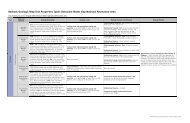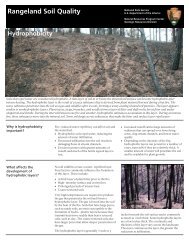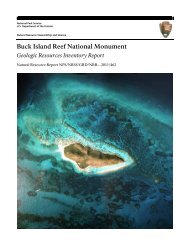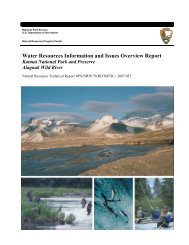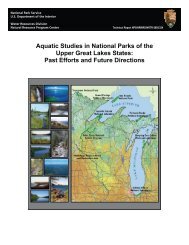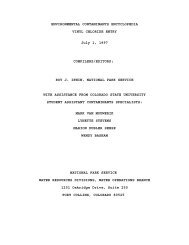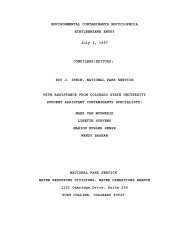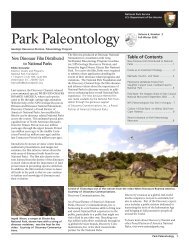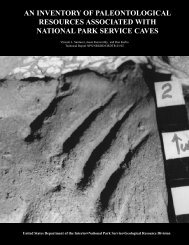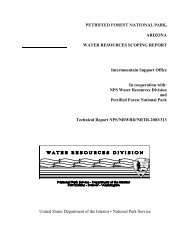toluene - National Park Service
toluene - National Park Service
toluene - National Park Service
Create successful ePaper yourself
Turn your PDF publications into a flip-book with our unique Google optimized e-Paper software.
were significant differences between these two groups. At<br />
higher concentrations of 2500 and 3500 ppm, the increase in<br />
the free p-cresol levels was remarkable only in Donryu rats,<br />
reaching the levels of Sprague-Dawley and Wistar rats, while<br />
the level in Fischer rats remained unchanged. [Inoue O et al;<br />
Bull Environ Contam Toxicol 43 (1): 74-9 (1989).<br />
The mutual metabolic suppression between benzene and <strong>toluene</strong><br />
was studied. The subjects, 190 male Chinese workers employed<br />
in shoe manufacturing, printing, audio equipment manufacture,<br />
and automobile industries, were divided into four groups based<br />
on occupational exposure: 65 were exposed to benzene, 35 to<br />
<strong>toluene</strong>, 55 to both compounds, and 35 served as comparisons.<br />
The arithmetic mean exposure level of benzene was 31.9 and of<br />
<strong>toluene</strong> 44.7 ppm. The mixture contained benzene at 17.9 +/29.3<br />
and <strong>toluene</strong> at 20.5 +/25.8 ppm. The exposure levels were<br />
measured using individuals diffusive samplers. The geometric<br />
mean levels of the metabolites, phenol, catechol,<br />
hydroquinone, hippuric acid, and o-cresol, in unexposed<br />
workers were 6.9, 9.4, 4.8, 72.5, and 0.066 mg per liter,<br />
respectively. Values corrected for creatinine and specific<br />
gravity were different from the values cited above. Multiple<br />
correlation coefficients for benzene exposure versus its three<br />
metabolites were for phenol, 0.740; for catechol, 0.629; and<br />
for hydroquinone, 0.726. Multiple correlation coefficients for<br />
<strong>toluene</strong> and its two metabolites were 0.649 for hippuric acid<br />
and 0.583 for o-cresol. The slopes of regression lines for the<br />
exposure to benzene in the presence of <strong>toluene</strong> were less than<br />
half of those obtained when the workers were exposed to<br />
benzene alone; however, the regression lines for benzene in<br />
mixture versus catechol were about 80% or higher than the<br />
lines observed with benzene as the sole pollutant. The<br />
regression lines for <strong>toluene</strong> in the mixture and excretion<br />
level of hippuric acid and o-cresol showed reduced metabolic<br />
conversion compared to when exposure was limited to <strong>toluene</strong><br />
alone. It was concluded that simultaneous exposure to benzene<br />
and <strong>toluene</strong> results in mutual suppression of metabolism<br />
yielding the urinary metabolites phenol, hydroquinone,<br />
hippuric acid, and o-cresol. [Inoue O et al; Int Arch Occup<br />
Environ Health 60 (1): 15-20 (1988).<br />
Water Data Interpretation, Concentrations and Toxicity (All Water<br />
Data Subsections Start with "W."):<br />
W.Low (Water Concentrations Considered Low):<br />
No information found.<br />
W.High (Water Concentrations Considered High):<br />
Concentrations of 22 ug/L were recorded following a spill<br />
into surface water [866].



